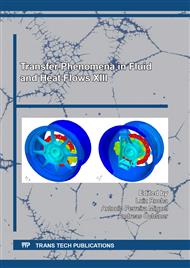[1]
F. Harb M.P. Hidalgo, and B. Martau, Lack of exposure to natural light in the workspace is associated with physiological, sleep and depressive symptoms. Biol Rhythm Res. 32(3) (2015) 368-375.
DOI: 10.3109/07420528.2014.982757
Google Scholar
[2]
F. Benedetti, F., et al., Morning sunlight reduces length of hospitalization in bipolar depression. J Affect Disord. 62(3) (2001) 221-223.
DOI: 10.1016/s0165-0327(00)00149-x
Google Scholar
[3]
C. Wang, V.L. How, and H. Abdul-Rahman, The performance of solar bottle bulbs at different interior exposure levels. Light Res Technol. 47(1) (2013) 116-127.
DOI: 10.1177/1477153513505584
Google Scholar
[4]
C. Wang, et al., Critical view on daylighting through solar bottle bulb. Build Res. 61(2) (2014) 115-128.
Google Scholar
[5]
Information on https://www.inegi.org.mx/programas/intercensal/2015/.
Google Scholar
[6]
F. Welle, Twenty years of PET bottle to bottle recycling—An overview. Resour Conserv Recycl. 55(11) (2011) 865-875.
DOI: 10.1016/j.resconrec.2011.04.009
Google Scholar
[7]
D. Izabal-Nogueda, Life cycle assesment of PET bottle recycling: a case study for Mexico. Environ Technol & Int Aff. (2013) 1-58.
Google Scholar
[8]
N.A. El Essawya, et al., Green synthesis of graphene from recycled PET bottle wastes for use in the adsorption of dyes in aqueous solution. Ecotoxicol Environ Saf. 145 (2017) 57-68.
DOI: 10.1016/j.ecoenv.2017.07.014
Google Scholar
[9]
J.M.C. Ongpeng, et al., Strengthening rectangular columns using recycled PET bottle strips. Int J Eng Sci Technol. 24(2) (2021) 405-413.
DOI: 10.1016/j.jestch.2020.07.006
Google Scholar
[10]
C. Dombre, et al., Aromatic evolution of wine packed in virgin and recycled PET bottles. Food Chem. 176(1) (2015) 376-387.
DOI: 10.1016/j.foodchem.2014.12.074
Google Scholar
[11]
Information on https://thefoodtech.com/historico/recicla-estado-de-mexico-solo-2-del-pet-que-consume/.
Google Scholar
[12]
Information on https: //www.noao.edu/education/QLTkit/ACTIVITY_Documents/Safety/LightLevels_ outdoor+ indoor.pdf.
Google Scholar
[13]
T.V. Pabari, A Study on the Solar Illumination Provided by a Water Bottle. Int. J. Appl. Eng. Res. 3(8) (2016) 690-696.
Google Scholar
[14]
L. Issolio and F. Buriek, Photometric Performance of the Solar Bottle Bulb. J Light Vis Environ. 39 (2015) 35-42.
DOI: 10.2150/jlve.ieij150000567
Google Scholar
[15]
Rigel, E.G., et al., Ultraviolet Radiation in Alpine Skiing; Magnitude of Exposure and Importance of Regular Protection. Arch Dermatol. 139 (2003) 60-62.
DOI: 10.1001/archderm.139.1.60
Google Scholar


